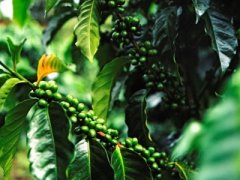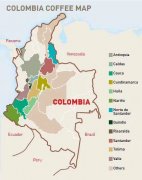The Development History of Saint Ario Manor in Colombia the path chosen by the owner of Saint Ali'o Manor
Saint Ario Manor of Colombia
For many years in Colombia's boutique coffee farm, San Tuareo Manor has been a leader in technology and planting methods in the industry, the soul of which is the manor owner Camilo (Camilo Merizalde). Camilo was born in the Valle de Cauca Valley of Colombia. From an early age, he often went to the coffee farm near his home and watched adults process coffee, until he decided to study in the United States after graduating from high school. When he worked as a manager of a Colombian food and beverage factory in the United States after graduation and often had the opportunity to go back to his hometown of Colombia to buy raw coffee beans, Camilo began to wonder why Colombian coffee could not be compared with Africa and Central America in terms of quality. Colombian coffee is often not considered to be one of the boutique coffee producers. During this period, Camilo began to study and read knowledge and books about coffee planting in the United States, hoping to grow stunning boutique coffee. At the same time, Camilo kept looking for estates with high-quality microclimate in Colombia, until he finally found the best farmland in Colombia's Cauca province in 2000. At this time, Camilo immediately embarked on the transformation of the estate, large and small, ready to realize the ideal coffee farm concept in this manor named San Tuareo (Finca Santuario).
In the first step, Camilo decided to start with the improvement of the soil quality in the manor, by planting a large number of ash leaf plants to provide rich and natural nitrogen, while retaining many native plants and fruit trees to provide a diversified source of nutrients. Camilo then began to analyze the topography of the manor and divided it into 266 different micro-blocks. To make it easier for landowners to track and manage the growth of coffee and changes in microclimate in the park. The second step is to start selecting the coffee varieties to be planted. Camilo made up his mind at the very beginning to choose the native varieties with low yield and good quality, and finally planted the first Tibica coffee tree in November 2002. until today, many excellent varieties have been expanded in the garden of Saint-Tuareo, such as Tibika, brothel, bourbon, pointed Bourbon and so on. Ganzhuang Garden is as high as 1950-2050 meters above sea level, with a large temperature difference between day and night and covered with volcanic ash soil, so it is especially suitable for the cultivation of these delicate varieties. The third step is to build their own washing treatment plant and exposure drying room, and the drying chamber has a lot of very advanced equipment in Colombia. Camilo first installed a large exhaust fan on both sides of the drying chamber. The principle of exhaust fan is used to accelerate air flow, which can not only avoid excessive fermentation of raw beans, but also stably control the temperature of the exposure room. Camilo, with full experimental spirit, has improved the washing equipment in the washing plant through the experience of working with 2015WBC champion Sasa Sestic, using the design of stainless steel buckets and fillets to greatly improve quality stability and sweetness.
After years of hard work, Camilo's first batch of San Tu Ali raw beans were officially exported in 2005, and today they have become the first choice for many contestants. In addition to WBC champion Sasa Sestic, Australian barista champion Matt Perger in 2013 also praised the raw beans of Saint Tu Ali'o and won the second place in WBC World Series by combining with EK43 bean mill that year. Camilo is constantly trying and experimenting with many new ways to improve the quality of coffee in his experience of working with these contestants, and more flavor and unique varieties of the manor are always found in the annual cup test.

Important Notice :
前街咖啡 FrontStreet Coffee has moved to new addredd:
FrontStreet Coffee Address: 315,Donghua East Road,GuangZhou
Tel:020 38364473
- Prev

Detailed introduction of flavor and taste of selected batches in Suri micro-producing area of Coca Zhuoyue Cup, Colombia.
Columbia Coca Zhuo Cup Suri micro-producing area selected flavor: dry aroma of citrus and lemon peel, sweet and sour taste of apple juice and lime, grapefruit, grapefruit, white grape juice, and fresh yogurt in the middle. The texture is like the rich acidity of delicate East African coffee, while the finish rhyme is the round flavor of Japanese matcha. The north-south vertical of the three Codiera mountains in Colombia
- Next

Starbucks Coffee Bean selection Series | Coffee Story of Cerro Asul 01 in Rose, Colombia
For the exchange of professional baristas, please follow the coffee workshop (Wechat official account cafe_style) Starbucks coffee bean selection series | Cerro Asul 01 coffee production in Colombia. Colombia has always been a large coffee grower, once contributed 10% of the total global coffee production and is an important producer of bulk commercial Arabica coffee. The existing coffee growing areas are generally divided.
Related
- Detailed explanation of Jadeite planting Land in Panamanian Jadeite Manor introduction to the grading system of Jadeite competitive bidding, Red bid, Green bid and Rose Summer
- Story of Coffee planting in Brenka region of Costa Rica Stonehenge Manor anaerobic heavy honey treatment of flavor mouth
- What's on the barrel of Blue Mountain Coffee beans?
- Can American coffee also pull flowers? How to use hot American style to pull out a good-looking pattern?
- Can you make a cold extract with coffee beans? What is the right proportion for cold-extracted coffee formula?
- Indonesian PWN Gold Mandrine Coffee Origin Features Flavor How to Chong? Mandolin coffee is American.
- A brief introduction to the flavor characteristics of Brazilian yellow bourbon coffee beans
- What is the effect of different water quality on the flavor of cold-extracted coffee? What kind of water is best for brewing coffee?
- Why do you think of Rose Summer whenever you mention Panamanian coffee?
- Introduction to the characteristics of authentic blue mountain coffee bean producing areas? What is the CIB Coffee Authority in Jamaica?

